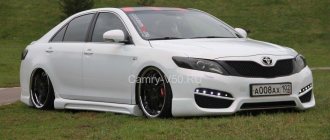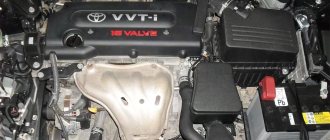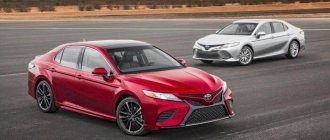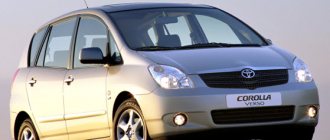Let's assume you have enough money for a car like a Toyota Camry or Nissan Teana. Which car of these two should you prefer? What's better? Let's try to answer this question.
These sedans are among the most popular cars on the Russian market among buyers. Camry and Teana are the most prominent representatives of this body in the middle and business class. The owner of such a car receives fairly high comfort at an affordable price.
The first model has been the undisputed sales leader in this segment for many years and is clearly not going to lose ground. It gained millions of fans and became the benchmark for an executive car in its price range. The second model for a long time occupied a catching-up position, inferior to our “champion,” but in the last year it tried to quickly come forward and catch up with the leader, and, possibly, overtake him. Will the multiple winner be able to retain the title, or will his rival's ambitions and strengths prevail in this fight? Let's compare these cars and find out the answer. In the “blue corner” is the absolute champion and holder of the title “best-selling sedan in Russia” - the fifth-generation Toyota Camry, and in the “red corner” is its rival, the third-generation Nissan Teana, striving for victory - the latest models to date.
Interior, trunk and options
One of the most important indicators that people first pay attention to when buying a business class car is the interior, in particular space. Both models always had plenty of room for passengers in both the front and rear. Although the Nissan appears to be a larger car on the outside, the latest version of the Camry is more spacious inside than its rival. However, by and large, second-row passengers will be comfortable in both cars.
Speaking about the rear seats of Toyota in the maximum configuration, it is worth noting that on the back side of the armrest there is a small control panel with which you can adjust the angle of the seat backs, the temperature of the climate control, the volume of the radio and scrolling through the tracks in the playlist. This option not only makes the ride more comfortable for second-row passengers, but also reduces driver distraction. There are no such “goodies” in the new Teana. The competitor's rear armrest is limited to just cup holders and heated seat buttons.
Opening the trunk in both models, we realize that Nissan continues to be slightly inferior to Toyota. The usable trunk volume of the Teana is 474 liters, while that of the Camry is 506 liters. It is noteworthy that the maximum modification of Toyota has a mechanism for adjusting the tilt of the second row seats. Since it is located next to the trunk, its placement consumes part of the usable volume. But even in this case, the Camry’s trunk volume is 483 liters, which is still 11 liters more than that of the contender for the title of “champion” of the best-selling sedans in Russia.
At first glance, it may seem that the Toyota Camry is the undisputed leader, but this is not so. Although the Toyota's interior is more solid and ergonomic, the car is not ready to offer buyers all the technical equipment of Nissan, even in the maximum configuration. The premium version of the Nissan Teana is equipped with a system for monitoring blind spots, recognizing moving objects from the rear of the body, monitoring lanes and other options that greatly simplify the life of the driver. Unlike the leader, it has a front seat ventilation system.
One of the most convenient options available in Nissan, but not available in Toyota, are cameras located around the perimeter of the car. The Camry is equipped only with a rear camera that displays the image on the dashboard screen, while the Nissan driver has the opportunity to get an all-round view. Each camera takes a separate picture, but on the Teana monitor you see your car from above, along with objects moving around you. A big fat plus in favor of the applicant. But this, of course, is not enough to win.
Comparing Nissan Teana and Toyota Camry gearboxes
The transmission of both cars is front-wheel drive, but the torque is realized and transmitted to the wheels by completely different units.
Toyota only uses classic automatic transmissions on displacement engines. A simple adaptive 6-speed Aisin gearbox is installed here (so to speak). It is reliable; problems rarely arise with it, and if such do occur, it is most often due to improper operation and improper maintenance. Since any 6-speed automatic transmission is very demanding on the quality of the oil, and in order to avoid any problems with this transmission, service technicians recommend changing the ATF fluid at least every 60,000 km, and the oil with filter at least every 120,000 km. and everything with this box should be in order.
Nissan now has no front-wheel drive automatic transmissions left; they have completely switched to the CVT transmission option. This is a continuously variable V-belt variator, which is characterized by greater comfort, due to the absence of jerks during gear shifts, as is the case with an automatic transmission, and reduced fuel consumption, since a smooth change in the gear ratio in the variator does not affect engine speed.
Race car drivers don't like these transmissions. In view of its design and the so-called “protection from fools”, the variator, due to its design features, has belt slipping on the plates up to 70 km/h, accordingly, it does not like quick starts, sharp accelerations, long slips, and everything that can increase the already considerable belt friction. History knows many cases of failure of CVTs on Nissan Teana, and when buying a car on the secondary market, few people know for sure how this car was driven before.
Engine and transmission
For 2021, the third generation Nissan Teana has prepared two types of engines for the Russian market:
- Inline four with a volume of 2.5 liters;
- V6 volume 3.5 liters.
For Toyota Camry, things are more varied:
- 2.0 liter four-cylinder engine;
- Four 2.5 l;
- V6 volume 3.5 liters.
In terms of power, Nissan loses in all categories. For 2.5 liter engines. it produces 172 hp. versus 181 hp Toyota has a 3.5 liter engine. develops 249 hp versus 268 hp
The Teana has a variator as a gearbox, due to which the shifting is not felt. The car drives smoothly, without jolts. If you miss the drive that came with shifting gears and the accompanying vibrations, switch the lever to the Ds position. It will give you back your former thrill. The Camry also has a CVT, but the model primarily comes with a 4-speed and a 6-speed automatic. Compared to its opponent, the “champion” box behaves nervously: the engine operates at higher speeds, switching is delayed, and ambiguous dynamics make you distracted. Yes, this car is faster, but when you press the gas pedal in the Camry, you lose the feeling of comfort and lightness that does not leave us in the Teana’s cabin at any speed.
Appearance of Camry and Teana
Both cars have undergone design changes. Moreover, these changes had a particularly positive effect on Nissan; the car looks less puffy and loose. Now the body looks more like an athlete with a clearly defined relief.
But Toyota's design solutions added majesty to it. It began to look even more monumental, perhaps due to a visual increase in length. Both cars have smooth silhouettes, nothing superfluous. In general, the cars look modern, without any elements that stand out from the general style.
Controllability
As for the handling of the “Japanese”, it is quite difficult to make a clear verdict. Let's take it in order. The Camry clearly lacks steering feedback. It lacks rigidity and dangles from side to side. This is slightly disconcerting as the driver loses a sense of control over the car. It turns out that strong feedback is clearly not Toyota’s strong point. However, with Teana, things are exactly the opposite - the steering wheel is hard and responsive, instantly reacts to the movement of the driver’s hands and implements all his maneuvers. This applies equally to both small manipulations and turns at a serious angle. In addition, Nissan has no problems with turning. Toyota clearly loses in this indicator. On high-speed turns, you get the feeling that after the front wheels rotate, time must pass for the rear wheels to join in the maneuver. But once you switch from Sport mode to smooth driving, everything falls into place: the Camry drives smoothly, neatly and precisely.
One of the main indicators of the suspension of business-class cars is sensitivity to irregularities. In this regard, Toyota unconditionally wins - bumps and changes in road terrain are almost unnoticeable. Considering that the comparison of models is made on Russian roads, the condition of which leaves much to be desired, you will definitely feel more comfortable in a Toyota.
Sores
A new car is almost always immaculate. However, to complete the picture, when comparing, you should pay attention to the weak points and sores of both opponents. Moreover, enough time has passed since the release of the latest versions, and drivers have formed a certain opinion about cars.
Weaknesses of Toyota Camry
Compared to the v40 modification, the interior of the fifth generation Camry model looks more solid. There are no “pseudo-wooden” elements, and the interior is richer. However, the quality of the filler leaves much to be desired. Some time after purchase, the seats sag and the leather stretches. The armrest does not have a sufficiently rigid frame, so under regular pressure it can also lose its shape. Of course, if these defects are present, the service will replace the filler under warranty, but the very fact that this issue exists on a business-class car is alarming.
Another major drawback is the paintwork. Toyota manufacturers clearly saved money on this. On average, the thickness of the paintwork is 100-120 microns, which is a fairly low figure. The car begins to rot from the inside - rust appears on the inside of the hood and trunk. There is traditionally only a primer about 50 microns thick. Therefore, if you are purchasing a used car, look under the hood.
There are no obvious complaints regarding the engine, gearbox and chassis. Everything is within the stated mileage. However, you should be careful when purchasing a Toyota with a 1.8 liter engine. It will not be easy to pull a car weighing 1.5 tons. The most popular types of power units are 2 and 2.5-liter engines.
Weaknesses of the Nissan Teana
As for the new Teana, it has also become noticeably better than the second generation model (J32). Previous models were criticized primarily for their handling. In the L33 body the car became much more pleasant to drive. At the same time, the comfort for which the ancestor was so valued remained at the same high level. But along with the advantages, the new model also inherited weaknesses. The variator remained a problem area in the car. It is extremely important to monitor the timely change of oil in the box and avoid stress - slipping on a CVT is prohibited. By following these recommendations, you can extend the life of the transmission.
Opponents have common weak points - this is the paintwork. On Nissan, the paint also begins to chip at the slightest impact, and corrosion quickly forms at the site of the chip. The best way out of the situation would be repainting. Moreover, it is better to do this at your own expense, since the paintwork applied under warranty is not of particular quality.
According to this indicator, both models have flaws, although not critical. Therefore this round is a draw!
What Teana II and Camry VI (XV40) can boast of
Both models have the proper level of comfort. Even in the basic configuration, they have driver and passenger airbags, electric drives for all windows, dual-zone climate controls and initial audio preparation. They also have an immobilizer and central locking.
But some things are different. The Camry boasts standard airbags - side and curtain type. At Teana, these pillows are available only at “maximum” settings.
In terms of electronic systems, both models also have everything in common: all the “trend” ones at the time of their release are present: ABS, EBD and BAS.
All differences between models come with an increase in options in older trim levels. For example, in the TOP, Teana has options such as ESP stability control system, bi-xenon headlights, cruise control, and so on. But Camry also has it all in the TOP. There are even more options: a rain and light sensor, a “Start-Stop” button.
Separately, the rear row of seats is adjustable back and forth, like the front ones, and it has a variable backrest angle. Why not business class?
Price
In the Russian market, Camry has won recognition due to its design, aggressive but attractive appearance, comfortable and spacious ride, and safety. The car was tested for crash stability by independent Australian company ANCAP and received a high rating of 5 stars. In addition, the Toyota Camry has always had an affordable price, although recently it has been noticeably inferior in availability to the Nissan Teana.
To be fair, it should be said that both models are assembled in Russia. However, the cost of Toyota for 2021 ranges from 1,407,000 to 2,000,009 rubles. depending on the configuration. And Nissan’s price range starts at 1,293,000 and ends at 1,754,000 rubles. Moreover, owners of the maximum version of Teana Premium Plus will receive 18'' wheels and a sunroof, which the competitor does not have.
What Nissan Teana and Toyota Camry are hiding on the secondary market
Let's see what the secondary market is ready to offer to the buyer of these models. Let's check cars for sale through the Autocode service by their license plate number.
It's a nice looking car, but there's no explanation in the ad. Having carefully analyzed the report, we identify a number of shortcomings.
The car had an accident, which, judging by the insurance calculations, was not serious.
But special attention should be paid to the collateral. This means that the mortgagee can take the car at any time, because it is he who owns the car until the debt is repaid.
If you look at the advertisements for Camry, there are no less situations when the car has several problems. We were attracted by this ad:
Similar to the Teana, this car, judging by the ad, has no obvious signs of an accident. And it was.
One accident in 2015. But, most likely, not serious - “Collision into a standing vehicle.” This could also happen if parking near the house was unsuccessful.
But inaccuracies in mileage already give reason to think before purchasing. In 2021, 241 thousand mileage was recorded on the diagnostic card. And in 2021 – already 125 t.km. Perhaps the mileage is twisted. And if, due to the general condition of the body, the hidden high mileage may not appear, then on the internal systems and assemblies this will appear at the next maintenance.
Over the past 30 days, vigilant buyers have checked through the Autocode service
almost 6,000 Nissan Teana cars and about 35,000 Toyota Camry.
We analyzed the database and found that most often both models get into accidents. Less often they have skewed runs or unpaid fines. Pawn cars are often found.
Summarizing
Both “Japanese” are good in their own way. Each has its own advantages and clients. The Toyota Camry is a little more spacious and elegant, but the Nissan Teana is more technologically advanced. Camry more clearly emphasizes the status of the owner, but Teana is more modern and more clearly meets the challenges of the time. The first has a powerful engine and excellent “swallowing” of bumps on the road, while the second has smoother gear shifts and better steering response. One is safer and the other is cheaper. Who won? There is probably a winner for every car owner.
Objectively looking at the sales figures, it becomes clear that no one has knocked Camry off its pedestal. It’s difficult to say what things will be like in the future. Toyota knows the “secret of success” and gives Russian customers what they want – comfort, safety and status. In addition, Toyota as a brand is still more loved in our country. Will Nissan be able to outshine its competitor in a few years? We'll see. In the meantime, we are dealing with the undefeated king - Toyota Camry.
See also:
- Comparison of Toyota Camry and Mazda 6
- Which is better: Honda Accord or Toyota Camry?
- Comparison of Toyota Camry and Volkswagen Passat
- Comparison of KIA Optima and Toyota Camry
Comparison of technical characteristics
| Nissan Teana 2.5 | Toyota Camry 2.5 | |
| Dimensions (L x W x H) | 4 863 × 1 830 × 1 482 | 4 825 × 1 825 × 1 480 |
| Curb weight, kg | 1 492 | 1 510 |
| Ground clearance, mm | 150 | 160 |
| Trunk volume, l | 474 | 506 |
| Fuel tank capacity l | 68 | 70 |
| Engine | petrol 2.5 l 172 hp | petrol 2.5 l 181 hp |
| Transmission | variable speed drive | automatic (6 speed) |
| Drive unit | front | front |
| Acceleration 0-100 km/h, pp. | 9.8 | 9 |
| Maximum speed, km/h | 210 | 210 |
| Average fuel consumption, l/100 km | 7,5 | 7,8 |
See all posts by tags: Camry, Nissan, Teana, Toyota










